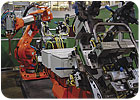Lander Automotive Ltd. (Birmingham, UK) manufactures welded tubular structures, including seating components, for the automotive industry.

Lander Automotive Ltd. (Birmingham, UK) manufactures welded tubular structures, including seating components, for the automotive industry. Recently, the company invested $1.3 million to install a flexible, mixed-mode assembly line to manufacture metal seat backs. The cells making up the line, which include CNC tube manipulators, presses, riveters and various assembly stations, extend some 75 feet. Central to the line’s success has been a series of five robots from ABB Inc. (Auburn Hills, MI), which performs a series of welding operations.
Near the front of the line are two cells where a pair of six-axis robots, each of which has a 5-kilogram payload capacity, welds the side towers and recliners on each seat back. A third cell uses another robot with a 5-kilogram capacity to weld the headrests. A fourth cell includes a powered turntable, which moves each assembly into position as a 175-kilogram robot spot-welds it together. Finally, a fifth cell uses twin 5-kilogram robots to weld various finishing components, like levers, into place. The cell also includes a manipulator, which turns over the seat back assemblies during these finishing operations. Transfer between cells is manual.
Lander programs each of the robots using a series SC4plus controller, also from ABB. The company elected to go with the SC4plus system in part because it had successfully used the system elsewhere in the factory. To control the overall line, Lander is using ABB’s new AC500 programmable logic controller. As part of the integration process, ABB engineers created a number of new software modules based on a programming approach known as EDDI (Error Diagnostically Driven Interface), which is a common standard in the car industry. All code complies with IEC 61131-3 and relies on tried and tested robotic and control interfaces.
ABB was also responsible for integrating the robots with the tooling in the cells, which were sourced by Lander from another supplier. Ultimately, ABB delivered everything on a tight, 15-week schedule, in spite of the development work involved.
In addition to the AC500 controller, ABB supplied a Profibus communication module so that the new cells could communicate with Lander’s plant-wide control system. Other ABB equipment included I/O cards, operator interfaces, power supplies, miniature circuit breakers, isolators, safety relays and mini relays.
For more on robotic assembly, call 248-393-4600 or visitwww.abb.com/us.